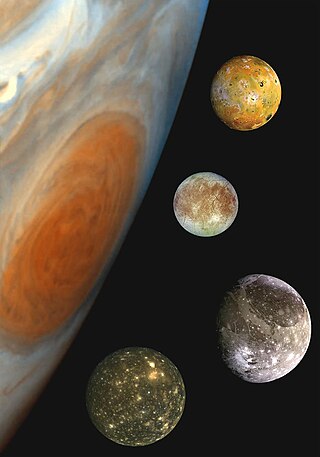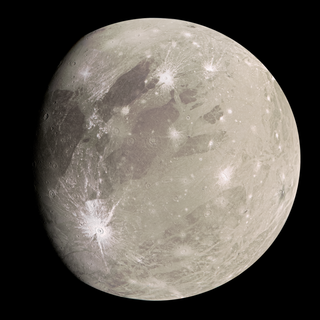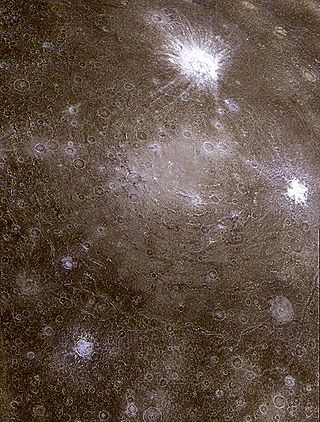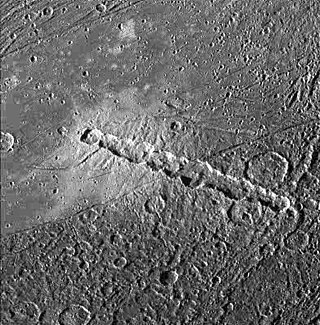
Keelut is a crater on Jupiter's moon Callisto. It is situated near the south pole and is an example of a central pit impact crater. It measures 47 km across. [1]
In the upper part of the image degraded Reginleif crater is visible.

Keelut is a crater on Jupiter's moon Callisto. It is situated near the south pole and is an example of a central pit impact crater. It measures 47 km across. [1]
In the upper part of the image degraded Reginleif crater is visible.

An impact crater is a circular depression in the surface of a solid astronomical body formed by the hypervelocity impact of a smaller object. In contrast to volcanic craters, which result from explosion or internal collapse, impact craters typically have raised rims and floors that are lower in elevation than the surrounding terrain. Impact craters range in size from microscopic craters seen on lunar rocks returned by the Apollo Program to simple bowl-shaped depressions and vast, complex, multi-ringed impact basins. Meteor Crater is a well-known example of a small impact crater on Earth.

The Galilean moons, or Galilean satellites, are the four largest moons of Jupiter: Io, Europa, Ganymede, and Callisto. They are the most readily visible Solar System objects after the unaided visible Saturn, the dimmest of the classical planets, allowing observation with common binoculars, even under night sky conditions of high light pollution. The invention of the telescope enabled the discovery of the moons in 1610. Through this, they became the first Solar System objects discovered since humans have started tracking the classical planets, and the first objects to be found to orbit any planet beyond Earth.

Callisto, or Jupiter IV, is the second-largest moon of Jupiter, after Ganymede. In the Solar System it is the third-largest moon after Ganymede and Saturn's largest moon Titan, and as large as the smallest planet Mercury, though only about a third as massive. Callisto is, with a diameter of 4,821 km, roughly a third larger than Earth's Moon and orbits Jupiter on average at a distance of 1,883,000 km, which is about six times further out than the Moon orbiting Earth. It is the outermost of the four large Galilean moons of Jupiter, which were discovered in 1610 with one of the first telescopes, being visible from Earth with common binoculars.

Ganymede, or Jupiter III, is the largest and most massive natural satellite of Jupiter and in the Solar System. It is the largest Solar System object without a substantial atmosphere, despite being the only moon in the Solar System with a substantial magnetic field. Like Titan, Saturn's largest moon, it is larger than the planet Mercury, but has somewhat less surface gravity than Mercury, Io, or the Moon due to its lower density compared to the three.
This is a directory of lists of geological features on planets excepting Earth, moons and asteroids ordered by increasing distance from the Sun.

Tindr is a crater on Jupiter's moon Callisto. It is named after one of the ancestors of Ottar in Norse mythology. This is an example of a central pit impact crater.

Hár is a crater on Jupiter's moon Callisto. Its name is one of the many names of Odin, the supreme god in Norse mythology. This is an example of a central dome impact crater.

Asgard is the second largest multi-ringed basin on Jupiter's moon Callisto. It is named after Asgard, the realm of the gods in Norse mythology. The central part of Asgard is dominated by the domed Doh impact crater.

Located on Jupiter's moon Callisto, Valhalla is the largest multi-ring impact crater in the Solar System. It is named after Valhalla, the hall where warriors are taken after death in Norse mythology.

A crater chain is a line of craters along the surface of an astronomical body. The descriptor term for crater chains is catena, plural catenae, as specified by the International Astronomical Union's rules on planetary nomenclature.

An impact structure is a generally circular or craterlike geologic structure of deformed bedrock or sediment produced by impact on a planetary surface, whatever the stage of erosion of the structure. In contrast, an impact crater is the surface expression of an impact structure. In many cases, on Earth, the impact crater has been destroyed by erosion, leaving only the deformed rock or sediment of the impact structure behind. This is the fate of almost all old impact craters on Earth, unlike the ancient pristine craters preserved on the Moon and other geologically inactive rocky bodies with old surfaces in the Solar System. Impact structure is synonymous with the less commonly used term astrobleme meaning "star wound".

Adlinda is the third-largest multiring structure on Jupiter's moon Callisto, measuring ~ 1000 km in diameter. It is situated in the southern hemisphere of Callisto. The name is taken from Inuit mythology.

Gomul Catena is a chain of craters on Jupiter's moon, Callisto. It is situated in the northern part of Valhalla multi-ring structure. The craters in the catena seem to have formed from east to west. Such features are thought to originate as secondary craters or due to fragmentation of the impactor.

Arcas is a crater on Jupiter's moon Callisto measuring 60 km (37 mi) across. It is an example of a central pit impact crater. A smaller crater near Arcas is called Ginandi. The crater is named after Arcas, the son of Callisto in Greek mythology.

Jalkr is a bright crater on Jupiter's moon Callisto measuring 74 km across. This an example of a central dome impact crater. A smaller degraded crater in the upper part of the image is called Audr.

Lofn is a large relatively young impact crater on Jupiter's Galilean satellite Callisto. It was identified in 1997 and named after the goddess of marriage in Norse mythology. Located near the south pole of this moon, Lofn is classified as a flat floored or anomalous dome impact crater. It is superimposed on Adlinda multilayer structure obscuring about 30 percent of it. Another multi-ring structure—Heimdall is found to the south-west of Lofn.

A palimpsest, in planetary astronomy, is an ancient crater that has been degraded over time. They may also be referred to as "ghost craters", "degraded craters", "buried craters", or "pathological craters". Palimpsests have been identified on Mercury, the Earth, the Moon, Mars, Ganymede, Callisto, and possibly even Titan. On Mars, these features are morphologically described as craters that are "flat-floored, rimless, extremely shallow, without central peaks, and would probably represent what remains after erosion."
![<span class="mw-page-title-main">Heimdall (Callistoan crater)</span> Crater on [[Callisto (moon)|Callisto]]](https://upload.wikimedia.org/wikipedia/commons/thumb/9/96/Callisto_USGS_global_small.jpg/320px-Callisto_USGS_global_small.jpg)
Heimdall is one of the largest known impact craters on Jupiter's Galilean satellite Callisto, with a diameter of 210 km. It is located near the Callistoan south pole at 63.5°S 3°E. It was firstly suspected on Voyager images, and later confirmed by Galileo.